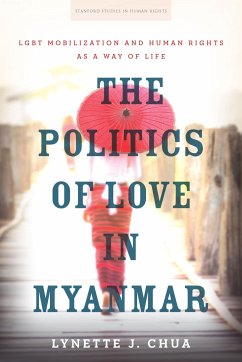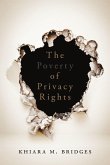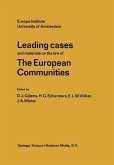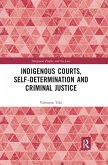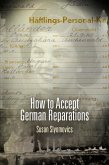- Broschiertes Buch
- Merkliste
- Auf die Merkliste
- Bewerten Bewerten
- Teilen
- Produkt teilen
- Produkterinnerung
- Produkterinnerung
Lynette J. Chua is Associate Professor of Law at the National University of Singapore. Her first book, Mobilizing Gay Singapore: Rights & Resistance in an Authoritarian State (2014), received the Distinguished Book Award from the American Sociology Association's Sociology of Law Section.
Andere Kunden interessierten sich auch für
![The Poverty of Privacy Rights The Poverty of Privacy Rights]() Khiara M BridgesThe Poverty of Privacy Rights31,99 €
Khiara M BridgesThe Poverty of Privacy Rights31,99 €![Leading Cases and Materials on the Law of the European Communities Leading Cases and Materials on the Law of the European Communities]() Leading Cases and Materials on the Law of the European Communities179,99 €
Leading Cases and Materials on the Law of the European Communities179,99 €![Indigenous Courts, Self-Determination and Criminal Justice Indigenous Courts, Self-Determination and Criminal Justice]() Valmaine TokiIndigenous Courts, Self-Determination and Criminal Justice56,99 €
Valmaine TokiIndigenous Courts, Self-Determination and Criminal Justice56,99 €![Who Gets Your Stuff When You Die: Solving the Puzzle: 14 Secrets for Protecting Everyone You Love & Everything You Own! Who Gets Your Stuff When You Die: Solving the Puzzle: 14 Secrets for Protecting Everyone You Love & Everything You Own!]() Leigh HiltonWho Gets Your Stuff When You Die: Solving the Puzzle: 14 Secrets for Protecting Everyone You Love & Everything You Own!18,99 €
Leigh HiltonWho Gets Your Stuff When You Die: Solving the Puzzle: 14 Secrets for Protecting Everyone You Love & Everything You Own!18,99 €![Looking for Love in the Legal Discourse of Marriage Looking for Love in the Legal Discourse of Marriage]() Renata GrossiLooking for Love in the Legal Discourse of Marriage30,99 €
Renata GrossiLooking for Love in the Legal Discourse of Marriage30,99 €![Catalogue of Offical Robes and Banners Catalogue of Offical Robes and Banners]() Catalogue of Offical Robes and Banners15,99 €
Catalogue of Offical Robes and Banners15,99 €![How to Accept German Reparations How to Accept German Reparations]() Susan SlyomovicsHow to Accept German Reparations38,99 €
Susan SlyomovicsHow to Accept German Reparations38,99 €-
-
-
Lynette J. Chua is Associate Professor of Law at the National University of Singapore. Her first book, Mobilizing Gay Singapore: Rights & Resistance in an Authoritarian State (2014), received the Distinguished Book Award from the American Sociology Association's Sociology of Law Section.
Hinweis: Dieser Artikel kann nur an eine deutsche Lieferadresse ausgeliefert werden.
Hinweis: Dieser Artikel kann nur an eine deutsche Lieferadresse ausgeliefert werden.
Produktdetails
- Produktdetails
- Verlag: Stanford University Press
- Seitenzahl: 232
- Erscheinungstermin: 25. Dezember 2018
- Englisch
- Abmessung: 227mm x 152mm x 16mm
- Gewicht: 358g
- ISBN-13: 9781503607446
- ISBN-10: 1503607445
- Artikelnr.: 50911632
- Herstellerkennzeichnung
- Libri GmbH
- Europaallee 1
- 36244 Bad Hersfeld
- 06621 890
- Verlag: Stanford University Press
- Seitenzahl: 232
- Erscheinungstermin: 25. Dezember 2018
- Englisch
- Abmessung: 227mm x 152mm x 16mm
- Gewicht: 358g
- ISBN-13: 9781503607446
- ISBN-10: 1503607445
- Artikelnr.: 50911632
- Herstellerkennzeichnung
- Libri GmbH
- Europaallee 1
- 36244 Bad Hersfeld
- 06621 890
Lynette J. Chua is Associate Professor of Law at the National University of Singapore. Her first book, Mobilizing Gay Singapore: Rights & Resistance in an Authoritarian State (2014), received the Distinguished Book Award from the American Sociology Association's Sociology of Law Section.
Contents and Abstracts
Introduction
chapter abstract
This introduces the book's central concept of human rights practice as a
way of life and presents an overview of the Burmese LGBT movement. It sets
out the three motivating questions of the book: How did the Burmese LGBT
movement emerge? How do LGBT activists of the movement make sense of human
rights and put them into action, that is, practice human rights? What are
the implications of their human rights practice? The chapter also explains
the significance of the book: a study about how human rights matter in a
society where they were suppressed for decades and where self-conceptions
have been informed by Buddhist beliefs and other cultural sources of
knowing, feeling, and interacting with the world.
1Human Rights Practice as a Way of Life
chapter abstract
This chapter elaborates on the book's central concept, human rights
practice as a way of life, to explain how it advances human rights studies
and sociolegal research on the relationship between rights and social
movements. This concept has three salient features: (1) The practice
comprises recursive, overlapping social processes of formation, grievance
transformation, and community building, (2) which are shaped by and shape
emotions and interpersonal relationships and (3) produce three outcomes:
self-transformation of the rights bearer, the creation of a distinctive
emotion culture, and the introduction of new claims by a new collective
claimant, LGBT rights for LGBT people, into Burmese politics. The chapter
also uses the concept to explain the flaws and limitations of Burmese LGBT
activists' human rights practice. By tracing processes and attending to
emotions and relationships, the concept emphasizes the complexities of
agency when assessing the power and prospects of human rights.
2Forming the Movement: Founding Emotions and Social Ties
chapter abstract
This chapter draws from the author's fieldwork to illustrate formation
processes, the first of three sets of processes that make up Burmese LGBT
activists' human rights practice as a way of life. As the chapter details
the movement's emergence from formation processes, it begins to show how
emotions and interpersonal relationships constitute human rights practice.
To get in touch with and encourage other Burmese to participate in their
human rights workshops and join the movement, movement pioneers make use of
preexisting ties rooted in all kinds of suffering caused by the violence of
the Burmese state and the discrimination of queer Burmese. By tapping these
relationships, they also stir up raw emotions that stem from the suffering,
affections toward movement leaders, and a mix of apprehension, courage, and
composure that recruits have to muster to answer their calls.
3Transforming Grievances: Emotional Fealty to Human Rights
chapter abstract
This chapter draws from the author's fieldwork to illustrate grievance
transformation, the second set of social processes of human rights practice
as a way of life. Grievance transformation elicits, remakes, and produces
emotions to cultivate Burmese LGBT activists' fealty to human rights and
perpetuate their practice. To make human rights relevant to their lives,
they engage familiar cultural schemas and resources, using common
experiences, Buddhist karmic beliefs and social norms that support the
movement's cause and sidelining those that are disadvantageous to it. Their
unique interpretation, centered around dignity, social belonging, and
responsibility, depicts human rights as a collective good to be
collectively achieved. The processes of grievance transformation lead to
three interrelated outcomes-self-transformation, distinctive emotion
culture, and new political claims of LGBT rights in Myanmar-demonstrating
how human rights practice has the potential to influence formal
institutions of law and politics from the bottom up.
4Building Community: Emotional Bonds Among Activists
chapter abstract
This chapter uses empirical details to illustrate community building, the
third set of processes in the human rights practice as a way of life.
Community-building processes engender affinity, camaraderie, solidarity,
and fellowship, which germinate affective ties among those who commit to
their practice, forming a community of Burmese LGBT activists. The bonds
emerge from the affinity of sharing the collective marker of "LGBT" and
from the social interactions involved in practicing human rights together.
They bind people together as LGBT activists, draw them to stay with the
movement, and sustain the practice itself. Community building contributes
to self-transformation, distinctive emotion culture, and new claims and
claimant by emphasizing LGBT identities as an embodiment of dignity,
facilitating bonding inclusive of all queer Burmese, and creating an LGBT
activist community. They further highlight the potential to influence
formal institutions of law and politics starting from personal and
grassroots changes.
5Faults, Fault Lines, and the Complexities of Agency
chapter abstract
This chapter examines the flaws and limitations of Burmese LGBT activists'
human rights practice as a way of life. Power dynamics, differences, and
divides among activists result in varying degrees of self-transformation
and adoption of their distinctive emotion culture. Their ability to make
LGBT rights claims is also hampered by deep norms, beliefs, power, and
hierarchy in Burmese society. Because the shortcomings arise from the
social processes of human rights practice, they also critically inform the
power and prospects of human rights to stimulate collective action and
social change. They are just as vital as the enthusiasm and optimism
encountered in previous chapters. The shortcomings, together with the
positive outcomes, indicate that human rights practice is far from
overtaking the old and entrenched modes of feeling, interacting, and
knowing already existing in Burmese society. Instead, with human rights,
LGBT activists offer an alternative way of life alongside others.
Conclusion
chapter abstract
This chapter takes stock of the book's central concept, human rights
practice as a way of life. It looks at the concept's principal features and
contributions to human rights scholarship as well as the sociolegal study
of rights and social movements. It considers the book's broader lessons for
understanding the potential of human rights to advance collective action
and attain social progress. It concludes with the intellectual premises
with which the book started: the socially contingent nature of human
rights, reflecting on what relational and emotional emphases mean for their
empirical study.
Introduction
chapter abstract
This introduces the book's central concept of human rights practice as a
way of life and presents an overview of the Burmese LGBT movement. It sets
out the three motivating questions of the book: How did the Burmese LGBT
movement emerge? How do LGBT activists of the movement make sense of human
rights and put them into action, that is, practice human rights? What are
the implications of their human rights practice? The chapter also explains
the significance of the book: a study about how human rights matter in a
society where they were suppressed for decades and where self-conceptions
have been informed by Buddhist beliefs and other cultural sources of
knowing, feeling, and interacting with the world.
1Human Rights Practice as a Way of Life
chapter abstract
This chapter elaborates on the book's central concept, human rights
practice as a way of life, to explain how it advances human rights studies
and sociolegal research on the relationship between rights and social
movements. This concept has three salient features: (1) The practice
comprises recursive, overlapping social processes of formation, grievance
transformation, and community building, (2) which are shaped by and shape
emotions and interpersonal relationships and (3) produce three outcomes:
self-transformation of the rights bearer, the creation of a distinctive
emotion culture, and the introduction of new claims by a new collective
claimant, LGBT rights for LGBT people, into Burmese politics. The chapter
also uses the concept to explain the flaws and limitations of Burmese LGBT
activists' human rights practice. By tracing processes and attending to
emotions and relationships, the concept emphasizes the complexities of
agency when assessing the power and prospects of human rights.
2Forming the Movement: Founding Emotions and Social Ties
chapter abstract
This chapter draws from the author's fieldwork to illustrate formation
processes, the first of three sets of processes that make up Burmese LGBT
activists' human rights practice as a way of life. As the chapter details
the movement's emergence from formation processes, it begins to show how
emotions and interpersonal relationships constitute human rights practice.
To get in touch with and encourage other Burmese to participate in their
human rights workshops and join the movement, movement pioneers make use of
preexisting ties rooted in all kinds of suffering caused by the violence of
the Burmese state and the discrimination of queer Burmese. By tapping these
relationships, they also stir up raw emotions that stem from the suffering,
affections toward movement leaders, and a mix of apprehension, courage, and
composure that recruits have to muster to answer their calls.
3Transforming Grievances: Emotional Fealty to Human Rights
chapter abstract
This chapter draws from the author's fieldwork to illustrate grievance
transformation, the second set of social processes of human rights practice
as a way of life. Grievance transformation elicits, remakes, and produces
emotions to cultivate Burmese LGBT activists' fealty to human rights and
perpetuate their practice. To make human rights relevant to their lives,
they engage familiar cultural schemas and resources, using common
experiences, Buddhist karmic beliefs and social norms that support the
movement's cause and sidelining those that are disadvantageous to it. Their
unique interpretation, centered around dignity, social belonging, and
responsibility, depicts human rights as a collective good to be
collectively achieved. The processes of grievance transformation lead to
three interrelated outcomes-self-transformation, distinctive emotion
culture, and new political claims of LGBT rights in Myanmar-demonstrating
how human rights practice has the potential to influence formal
institutions of law and politics from the bottom up.
4Building Community: Emotional Bonds Among Activists
chapter abstract
This chapter uses empirical details to illustrate community building, the
third set of processes in the human rights practice as a way of life.
Community-building processes engender affinity, camaraderie, solidarity,
and fellowship, which germinate affective ties among those who commit to
their practice, forming a community of Burmese LGBT activists. The bonds
emerge from the affinity of sharing the collective marker of "LGBT" and
from the social interactions involved in practicing human rights together.
They bind people together as LGBT activists, draw them to stay with the
movement, and sustain the practice itself. Community building contributes
to self-transformation, distinctive emotion culture, and new claims and
claimant by emphasizing LGBT identities as an embodiment of dignity,
facilitating bonding inclusive of all queer Burmese, and creating an LGBT
activist community. They further highlight the potential to influence
formal institutions of law and politics starting from personal and
grassroots changes.
5Faults, Fault Lines, and the Complexities of Agency
chapter abstract
This chapter examines the flaws and limitations of Burmese LGBT activists'
human rights practice as a way of life. Power dynamics, differences, and
divides among activists result in varying degrees of self-transformation
and adoption of their distinctive emotion culture. Their ability to make
LGBT rights claims is also hampered by deep norms, beliefs, power, and
hierarchy in Burmese society. Because the shortcomings arise from the
social processes of human rights practice, they also critically inform the
power and prospects of human rights to stimulate collective action and
social change. They are just as vital as the enthusiasm and optimism
encountered in previous chapters. The shortcomings, together with the
positive outcomes, indicate that human rights practice is far from
overtaking the old and entrenched modes of feeling, interacting, and
knowing already existing in Burmese society. Instead, with human rights,
LGBT activists offer an alternative way of life alongside others.
Conclusion
chapter abstract
This chapter takes stock of the book's central concept, human rights
practice as a way of life. It looks at the concept's principal features and
contributions to human rights scholarship as well as the sociolegal study
of rights and social movements. It considers the book's broader lessons for
understanding the potential of human rights to advance collective action
and attain social progress. It concludes with the intellectual premises
with which the book started: the socially contingent nature of human
rights, reflecting on what relational and emotional emphases mean for their
empirical study.
Contents and Abstracts
Introduction
chapter abstract
This introduces the book's central concept of human rights practice as a
way of life and presents an overview of the Burmese LGBT movement. It sets
out the three motivating questions of the book: How did the Burmese LGBT
movement emerge? How do LGBT activists of the movement make sense of human
rights and put them into action, that is, practice human rights? What are
the implications of their human rights practice? The chapter also explains
the significance of the book: a study about how human rights matter in a
society where they were suppressed for decades and where self-conceptions
have been informed by Buddhist beliefs and other cultural sources of
knowing, feeling, and interacting with the world.
1Human Rights Practice as a Way of Life
chapter abstract
This chapter elaborates on the book's central concept, human rights
practice as a way of life, to explain how it advances human rights studies
and sociolegal research on the relationship between rights and social
movements. This concept has three salient features: (1) The practice
comprises recursive, overlapping social processes of formation, grievance
transformation, and community building, (2) which are shaped by and shape
emotions and interpersonal relationships and (3) produce three outcomes:
self-transformation of the rights bearer, the creation of a distinctive
emotion culture, and the introduction of new claims by a new collective
claimant, LGBT rights for LGBT people, into Burmese politics. The chapter
also uses the concept to explain the flaws and limitations of Burmese LGBT
activists' human rights practice. By tracing processes and attending to
emotions and relationships, the concept emphasizes the complexities of
agency when assessing the power and prospects of human rights.
2Forming the Movement: Founding Emotions and Social Ties
chapter abstract
This chapter draws from the author's fieldwork to illustrate formation
processes, the first of three sets of processes that make up Burmese LGBT
activists' human rights practice as a way of life. As the chapter details
the movement's emergence from formation processes, it begins to show how
emotions and interpersonal relationships constitute human rights practice.
To get in touch with and encourage other Burmese to participate in their
human rights workshops and join the movement, movement pioneers make use of
preexisting ties rooted in all kinds of suffering caused by the violence of
the Burmese state and the discrimination of queer Burmese. By tapping these
relationships, they also stir up raw emotions that stem from the suffering,
affections toward movement leaders, and a mix of apprehension, courage, and
composure that recruits have to muster to answer their calls.
3Transforming Grievances: Emotional Fealty to Human Rights
chapter abstract
This chapter draws from the author's fieldwork to illustrate grievance
transformation, the second set of social processes of human rights practice
as a way of life. Grievance transformation elicits, remakes, and produces
emotions to cultivate Burmese LGBT activists' fealty to human rights and
perpetuate their practice. To make human rights relevant to their lives,
they engage familiar cultural schemas and resources, using common
experiences, Buddhist karmic beliefs and social norms that support the
movement's cause and sidelining those that are disadvantageous to it. Their
unique interpretation, centered around dignity, social belonging, and
responsibility, depicts human rights as a collective good to be
collectively achieved. The processes of grievance transformation lead to
three interrelated outcomes-self-transformation, distinctive emotion
culture, and new political claims of LGBT rights in Myanmar-demonstrating
how human rights practice has the potential to influence formal
institutions of law and politics from the bottom up.
4Building Community: Emotional Bonds Among Activists
chapter abstract
This chapter uses empirical details to illustrate community building, the
third set of processes in the human rights practice as a way of life.
Community-building processes engender affinity, camaraderie, solidarity,
and fellowship, which germinate affective ties among those who commit to
their practice, forming a community of Burmese LGBT activists. The bonds
emerge from the affinity of sharing the collective marker of "LGBT" and
from the social interactions involved in practicing human rights together.
They bind people together as LGBT activists, draw them to stay with the
movement, and sustain the practice itself. Community building contributes
to self-transformation, distinctive emotion culture, and new claims and
claimant by emphasizing LGBT identities as an embodiment of dignity,
facilitating bonding inclusive of all queer Burmese, and creating an LGBT
activist community. They further highlight the potential to influence
formal institutions of law and politics starting from personal and
grassroots changes.
5Faults, Fault Lines, and the Complexities of Agency
chapter abstract
This chapter examines the flaws and limitations of Burmese LGBT activists'
human rights practice as a way of life. Power dynamics, differences, and
divides among activists result in varying degrees of self-transformation
and adoption of their distinctive emotion culture. Their ability to make
LGBT rights claims is also hampered by deep norms, beliefs, power, and
hierarchy in Burmese society. Because the shortcomings arise from the
social processes of human rights practice, they also critically inform the
power and prospects of human rights to stimulate collective action and
social change. They are just as vital as the enthusiasm and optimism
encountered in previous chapters. The shortcomings, together with the
positive outcomes, indicate that human rights practice is far from
overtaking the old and entrenched modes of feeling, interacting, and
knowing already existing in Burmese society. Instead, with human rights,
LGBT activists offer an alternative way of life alongside others.
Conclusion
chapter abstract
This chapter takes stock of the book's central concept, human rights
practice as a way of life. It looks at the concept's principal features and
contributions to human rights scholarship as well as the sociolegal study
of rights and social movements. It considers the book's broader lessons for
understanding the potential of human rights to advance collective action
and attain social progress. It concludes with the intellectual premises
with which the book started: the socially contingent nature of human
rights, reflecting on what relational and emotional emphases mean for their
empirical study.
Introduction
chapter abstract
This introduces the book's central concept of human rights practice as a
way of life and presents an overview of the Burmese LGBT movement. It sets
out the three motivating questions of the book: How did the Burmese LGBT
movement emerge? How do LGBT activists of the movement make sense of human
rights and put them into action, that is, practice human rights? What are
the implications of their human rights practice? The chapter also explains
the significance of the book: a study about how human rights matter in a
society where they were suppressed for decades and where self-conceptions
have been informed by Buddhist beliefs and other cultural sources of
knowing, feeling, and interacting with the world.
1Human Rights Practice as a Way of Life
chapter abstract
This chapter elaborates on the book's central concept, human rights
practice as a way of life, to explain how it advances human rights studies
and sociolegal research on the relationship between rights and social
movements. This concept has three salient features: (1) The practice
comprises recursive, overlapping social processes of formation, grievance
transformation, and community building, (2) which are shaped by and shape
emotions and interpersonal relationships and (3) produce three outcomes:
self-transformation of the rights bearer, the creation of a distinctive
emotion culture, and the introduction of new claims by a new collective
claimant, LGBT rights for LGBT people, into Burmese politics. The chapter
also uses the concept to explain the flaws and limitations of Burmese LGBT
activists' human rights practice. By tracing processes and attending to
emotions and relationships, the concept emphasizes the complexities of
agency when assessing the power and prospects of human rights.
2Forming the Movement: Founding Emotions and Social Ties
chapter abstract
This chapter draws from the author's fieldwork to illustrate formation
processes, the first of three sets of processes that make up Burmese LGBT
activists' human rights practice as a way of life. As the chapter details
the movement's emergence from formation processes, it begins to show how
emotions and interpersonal relationships constitute human rights practice.
To get in touch with and encourage other Burmese to participate in their
human rights workshops and join the movement, movement pioneers make use of
preexisting ties rooted in all kinds of suffering caused by the violence of
the Burmese state and the discrimination of queer Burmese. By tapping these
relationships, they also stir up raw emotions that stem from the suffering,
affections toward movement leaders, and a mix of apprehension, courage, and
composure that recruits have to muster to answer their calls.
3Transforming Grievances: Emotional Fealty to Human Rights
chapter abstract
This chapter draws from the author's fieldwork to illustrate grievance
transformation, the second set of social processes of human rights practice
as a way of life. Grievance transformation elicits, remakes, and produces
emotions to cultivate Burmese LGBT activists' fealty to human rights and
perpetuate their practice. To make human rights relevant to their lives,
they engage familiar cultural schemas and resources, using common
experiences, Buddhist karmic beliefs and social norms that support the
movement's cause and sidelining those that are disadvantageous to it. Their
unique interpretation, centered around dignity, social belonging, and
responsibility, depicts human rights as a collective good to be
collectively achieved. The processes of grievance transformation lead to
three interrelated outcomes-self-transformation, distinctive emotion
culture, and new political claims of LGBT rights in Myanmar-demonstrating
how human rights practice has the potential to influence formal
institutions of law and politics from the bottom up.
4Building Community: Emotional Bonds Among Activists
chapter abstract
This chapter uses empirical details to illustrate community building, the
third set of processes in the human rights practice as a way of life.
Community-building processes engender affinity, camaraderie, solidarity,
and fellowship, which germinate affective ties among those who commit to
their practice, forming a community of Burmese LGBT activists. The bonds
emerge from the affinity of sharing the collective marker of "LGBT" and
from the social interactions involved in practicing human rights together.
They bind people together as LGBT activists, draw them to stay with the
movement, and sustain the practice itself. Community building contributes
to self-transformation, distinctive emotion culture, and new claims and
claimant by emphasizing LGBT identities as an embodiment of dignity,
facilitating bonding inclusive of all queer Burmese, and creating an LGBT
activist community. They further highlight the potential to influence
formal institutions of law and politics starting from personal and
grassroots changes.
5Faults, Fault Lines, and the Complexities of Agency
chapter abstract
This chapter examines the flaws and limitations of Burmese LGBT activists'
human rights practice as a way of life. Power dynamics, differences, and
divides among activists result in varying degrees of self-transformation
and adoption of their distinctive emotion culture. Their ability to make
LGBT rights claims is also hampered by deep norms, beliefs, power, and
hierarchy in Burmese society. Because the shortcomings arise from the
social processes of human rights practice, they also critically inform the
power and prospects of human rights to stimulate collective action and
social change. They are just as vital as the enthusiasm and optimism
encountered in previous chapters. The shortcomings, together with the
positive outcomes, indicate that human rights practice is far from
overtaking the old and entrenched modes of feeling, interacting, and
knowing already existing in Burmese society. Instead, with human rights,
LGBT activists offer an alternative way of life alongside others.
Conclusion
chapter abstract
This chapter takes stock of the book's central concept, human rights
practice as a way of life. It looks at the concept's principal features and
contributions to human rights scholarship as well as the sociolegal study
of rights and social movements. It considers the book's broader lessons for
understanding the potential of human rights to advance collective action
and attain social progress. It concludes with the intellectual premises
with which the book started: the socially contingent nature of human
rights, reflecting on what relational and emotional emphases mean for their
empirical study.

